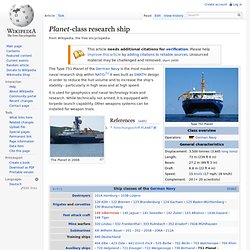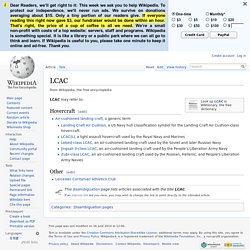

Ticonderoga-class cruiser. History[edit] Shoot down of Iran Air Flight 655[edit] Interception of United States satellite USA-193[edit] Possible early retirement[edit] Due to Budget Control Act of 2011 requirements to cut the Defense Budget for FY2013 and subsequent years, plans are being considered to decommission some of the Ticonderoga-class cruisers.[7] For the U.S.
Defense 2013 Budget Proposal, the U.S. Because of these retirements, the U.S. By October 2012, the U.S. Arleigh Burke-class destroyer. The Arleigh Burke class of guided missile destroyers (DDGs) is the United States Navy's first class of destroyer built around the Aegis Combat System and the SPY-1D multi-function phased array radar.

The class is named for Admiral Arleigh Burke, the most famous American destroyer officer of World War II, and later Chief of Naval Operations. The class leader, USS Arleigh Burke, was commissioned during Admiral Burke's lifetime. With an overall length of 505 feet (154 m) to 509 feet (155 m), displacement ranging from 8,315 to 9,200 tons, and weaponry including over 90 missiles, the Arleigh Burke-class ships are larger and more heavily armed than most previous ships classified as guided missile cruisers.[11] USS Bonhomme Richard (LHD-6)
USS Bonhomme Richard (LHD-6) is a Wasp-class amphibious assault ship, and the third United States Navy ship of that name.

It was named in honor of John Paul Jones' famous frigate, which he had named the French equivalent of "Good Man Richard," in honor of Benjamin Franklin, the U.S. Ambassador to France at the time. The name Bonhomme Richard is derived from the pen name of Benjamin Franklin, the author of Poor Richard's Almanac. The contract to build her was awarded to Ingalls Shipbuilding on 11 December 1992, and her keel was laid down on 18 April 1995. She was launched on 14 March 1997, delivered to the Navy on 12 May 1998, and commissioned on 15 August 1998.
Training ship. A training ship is a ship used to train students as sailors.

The term is especially used for ships employed by navies to train future officers. Essentially there are two types: those used for training at sea and old hulks used to house classrooms. The hands-on aspect provided by sail training has also been used as a platform for everything from semesters-at-sea for undergraduate oceanography and biology students, marine science and physical science for high school students, and character building for at-risk youths. In the Sea Cadet Corps all Units use a ship prefix "T.S. Notable training ships[edit] Planet-class research ship. The Type 751 Planet of the German Navy is the most modern naval research ship within NATO.[1] It was built as SWATH design in order to reduce the hull volume and to increase the ship's stability - particularly in high seas and at high speed.

It is used for geophysics and naval technology trials and research. While technically not armed, it is equipped with torpedo launch capability. Other weapons systems can be installed for weapon trials. Spruance-class destroyer. The Spruance-class destroyer was developed by the United States to replace a large number of World War II-built Allen M.

Sumner- and Gearing-class destroyers and was the primary destroyer built for the U.S. Navy during the 1970s. Sikorsky SH-60 Seahawk. This article is about the naval versions and operators of the S-70 family.

For an overview of the S-70 family, and for its civilian models and operators, see Sikorsky S-70. The Sikorsky SH-60/MH-60 Seahawk (or Sea Hawk) is a twin turboshaft engine, multi-mission United States Navy helicopter based on the United States Army UH-60 Black Hawk and a member of the Sikorsky S-70 family. The most significant airframe modification is a hinged tail to reduce its footprint aboard ships. The U.S. Navy uses the H-60 airframe under the model designations SH-60B, SH-60F, HH-60H, MH-60R, and MH-60S.
Design and development[edit] Arleigh Burke-class destroyer. Ticonderoga-class cruiser. Landing Craft Utility. French EDA-R catamaran on exercises in October 2012 with a more traditional design, the British LCU Mk10, in the foreground.

France[edit] The Engin de débarquement amphibie rapide (EDA-R) landing catamaran or L-CAT, entered service in January 2011. They can carry a main battle tank like other European LCUs, but are capable of much higher speeds, up to 30 knots (56 km/h; 35 mph). Germany[edit] Only two Barbe class utility landing craft (Type 520), dating from the mid-1960s, remain in service with SEK-M Naval Special Forces command, but Germany is looking to buy more.
Netherlands[edit] In 2005 and 2006 the five vessels were modernized to the type Mark II. United Kingdom[edit] LCAC. From Wikipedia, the free encyclopedia LCAC may refer to: Hovercraft[edit] Other[edit] Leicester Coritanian Athletics Club.

LCVP (United States) The Landing Craft, Vehicle, Personnel (LCVP) or Higgins boat was a landing craft used extensively in amphibious landings in World War II.

The craft was designed by Andrew Higgins based on boats made for operating in swamps and marshes. More than 20,000 were built, by Higgins Industries and licensees. Andrew Higgins started out in the lumber business but gradually moved into boatbuilding, which became his sole operation after the lumber transport company he was running went bankrupt in 1930. Most sources[who?] Hdw submarine. Sōryū-class submarine. The Sōryū-class submarines (16SS) are diesel-electric submarines that entered service with the Japan Maritime Self-Defense Force in 2009. The design is an evolution of the Oyashio class submarine, from which it can most easily be distinguished by its X-shaped tail planes. The Sōryūs have the largest displacement of any submarine used by post war Japan. HMS Invincible (R05) Invincible in the South Atlantic, during the Falklands War Invincible returns to the Solent after the Falklands War On 2 April 1982, however, Argentina invaded the Falkland Islands.
Three days later, a naval task force headed by Invincible and Hermes left HMNB Portsmouth bound for the South Atlantic and, on 20 April, the British war cabinet ordered the repossession of the Islands. Along with eight Sea Harriers, the Invincible's airgroup included twelve Sea King helicopters that were slightly larger than the ship had originally been designed to accommodate. Small machine guns were added around the flight deck and island for close-in defence. On 1 June, Australian Prime Minister Malcolm Fraser advised the British government that the sale of Invincible to Australia could be cancelled if desired. Between 1993 and 1995, Invincible was deployed in the Adriatic for Operation "Deny Flight" and then Operation "Deliberate Force" during the Yugoslav Wars.
Crane stores lighter telopea. ROKS dokdo. HMAS Stalwart. Admiral's barge royal australian navy. Training ship. Type 214 submarine. The Type 214 is a diesel-electric submarine developed by Howaldtswerke-Deutsche Werft GmbH (HDW). It features diesel propulsion with an air-independent propulsion (AIP) system using Siemens polymer electrolyte membrane (PEM) hydrogen fuel cells. The Type 214 submarine is derived from the Type 212,[2] but as an export variant it lacks some of the classified technologies of its smaller predecessor most important of which is the non magnetic steel hull which makes the Type 212 submarine impossible to detect using a Magnetic Anomaly Detector. A contract to build three boats for the Hellenic Navy was signed 15 February 2000 and a fourth one was ordered in June 2002. The first boat was built at HDW in Kiel, Germany and the rest at the Hellenic Shipyards Co. in Skaramangas, Greece.
Type 212 submarine. The German Type 212 class, also Italian Todaro class,[6] is a highly advanced design of non-nuclear submarine developed by Howaldtswerke-Deutsche Werft AG (HDW) for the German and Italian Navy. It features diesel propulsion and an additional air-independent propulsion (AIP) system using Siemens polymer electrolyte membrane (PEM) hydrogen fuel cells.
The submarine can operate at high speed on diesel power or switch to the AIP system for silent slow cruising, staying submerged for up to three weeks without surfacing and with no exhaust heat. The system is also said to be vibration-free, extremely quiet and virtually undetectable. Type 212 is the first of the only two fuel cell propulsion system equipped submarines ready for series production by 2007, the other being the Project 677 Lada class submarine designed by Russian Rubin Design Bureau. Development[edit] Kedah-class offshore patrol vessel. The Kedah class is a class of offshore patrol vessels (also classified as Corvette due to the tonnage, length and fitted for but not with), and referred as New Generation Patrol Vessels, of the Royal Malaysian Navy. The class is named after the lead ship of the class, KD Kedah. The Kedah class is based on the MEKO 100 design by Blohm + Voss. A total of 27 ships were planned; however, due to programme delays and overruns, only six were ordered.
Fridtjof Nansen-class frigate. French aircraft carrier Charles de Gaulle (R91) Iver Huitfeldt-class frigate. Hyūga-class helicopter destroyer. America-class amphibious assault ship. The America can be used as a small aircraft carrier with a squadron of jet fighters plus several multipurpose helicopters, such as the SH-60 Seahawk.
She can carry about 20 AV-8B Harriers, F-35Bs, or a mixture of the two, but the future ships of this class, starting with LHA-8 will have smaller aircraft hangars to leave room for smaller than usual amphibious warfare well decks.[5] Wasp-class amphibious assault ship. HMAS Success. Two ships of the Royal Australian Navy (RAN) have been named HMAS Success. Battle honours[edit] Ships named HMAS Success are entitled to carry two battle honours:[1][2] HMAS Sirius (O 266) Originally, the RAN planned to have a ship specially constructed for the role.[6] The decision to instead purchase an under-construction civilian tanker and modify her for military service allowed Sirius to enter service three years before originally planned, at a saving of half the acquisition project's cost.[6] On the morning of 13 March 2009, Sirius was one of seventeen warships involved in a ceremonial fleet entry and fleet review in Sydney Harbour, the largest collection of RAN ships since the Australian Bicentenary in 1988.[7] Sirius did not participate in the fleet entry, but was anchored in the harbour for the review.
In 2010, Sirius was approved to carry and deploy boarding parties.[2] This capability was tested during Exercise Kakadu 10, along with the ship's first ever dual replenishment.[2] Sirius was forced to turn back en route to the RIMPAC 2010 exercise in Hawaii due to problems with her engine, and did not participate in the exercise as a result.[8] Gillett, Ross (2012). Landing craft medium. De Zeven Provinciën-class frigate. De Zeven Provinciën-class frigates are highly advanced air-defence and command frigates in service with the Koninklijke Marine (Royal Netherlands Navy). This class of ships is also known as LCF (Luchtverdedigings- en commandofregat, air defense and command frigate). Oliver Hazard Perry-class frigate.
HMAS Stalwart. Collins-class submarine replacement project. SSN Astute Class Nuclear Submarine. Astute-class submarine. Ship-Submarine Recycling Program. Taking a peek at the Royal Navy's next nuclear-powered ballistic missile sub. Submarine. SSN. Category:Auxiliary ships of the Royal Australian Navy. Sea Fighter. Type 216 submarine. Type 214 submarine. Sōryū-class submarine. Oberon-class submarine. Collins-class submarine replacement project. Collins-class submarine. Karel Doorman-class support ship. Collins-class submarine replacement project. Collins-class submarine. HMAS Ovens. USNS Mercy (T-AH-19) Amphibious transport dock. Dock landing ship. America-class amphibious assault ship. Wasp-class amphibious assault ship. Spearhead-class joint high speed vessel. Armidale-class patrol boat. Procurement programme of the Royal Australian Navy. Flyvefisken-class patrol vessel. StanFlex. Planned Australian offshore combatant vessel. HMAS Tobruk (L 50) Huon-class minehunter. Seahorse Mercator.